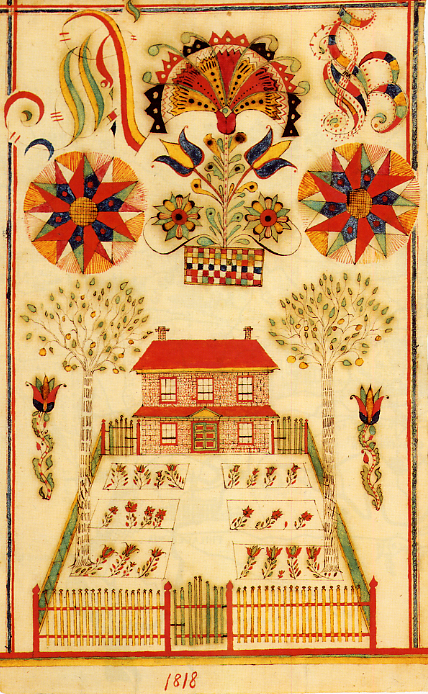CULTURAL SERVINGS:
EPHEMERAL ECHOES
EDWARDIAN PURSE
SCRIMSHAW AND LOVE TOKENS
PILCHARDS AND TROYL
BELTS
LEATHER TANNING
BEER TIME
BEER MATS
LUNCH BOX
SLOW MOVEMENT
SUMMER HEAT
NATURAL DYES
FRAKTUR ART
THE CRIES OF LONDON
SHAKER FURNITURE
BAUHAUS BRUTALISM
BAUHAUS INTERIOR
BAUHAUS SPIRIT
BAUHAUS HISTORY
ROMANTICISM AND REVIVAL
HISTORY OF THE MUSEUM
CABINETS OF CURIOSITY
FRAKTUR ART






EXPLORING GERMAN PENNSYLVANIA’S UNIQUE FOLK ART STYLE
Fraktur is a form of folk art which was practiced by Pennsylvanian Germans principally
from the mid-eighteenth to the mid-nineteenth centuries. The name derives from that of a distinctive German script marked by “fractured" pen strokes and the form has clear roots in European folk culture. Fraktur blossomed into a uniquely rich, colourful and iconographic form of expression in the United states, tied to rites of social life. Fraktur art commonly came in the form of decorated manuscripts, where lettering and illustration came together to create intricate designs that gave importance to pieces of writing.
Although rooted in medieval European manuscript art, fraktur also existed in America, and was more focussed on personal family records, rather than legal documents or text. They were created for many reasons: as teaching tools, to document births and baptisms, or to show ownership. They were often intended as a decorative memento rather than legal record of the events, and were meant to be displayed in the home.
Most fraktur created before 1900 used German as the preferred language. Although we have come to use the term, ‘fraktur’ to refer to this form of art, in standard German, the word actually refers to the decorative hand lettering similar to Old English or Gothic, and the typeface derived from it.
Fraktur was also created simply for fun. Some schoolmasters created drawings as rewards of merit for their students. Others were simply decorative pieces. Regardless of purpose, fraktur was attainable and personal art, and very popular with 19th century rural families of Pennsylvania.
REFERENCES
http://explorepahistory.com/displaygallery.php?gallery_id=1-7-C&bcolor=red&showimage=8
http://www.sothebys.com/en/auctions/ecatalogue/2014/so-esmerian-n09106/lot/655/html
https://digitalcommons.ursinus.edu/ursinus_fraktur/32/
http://frakturweb.org/